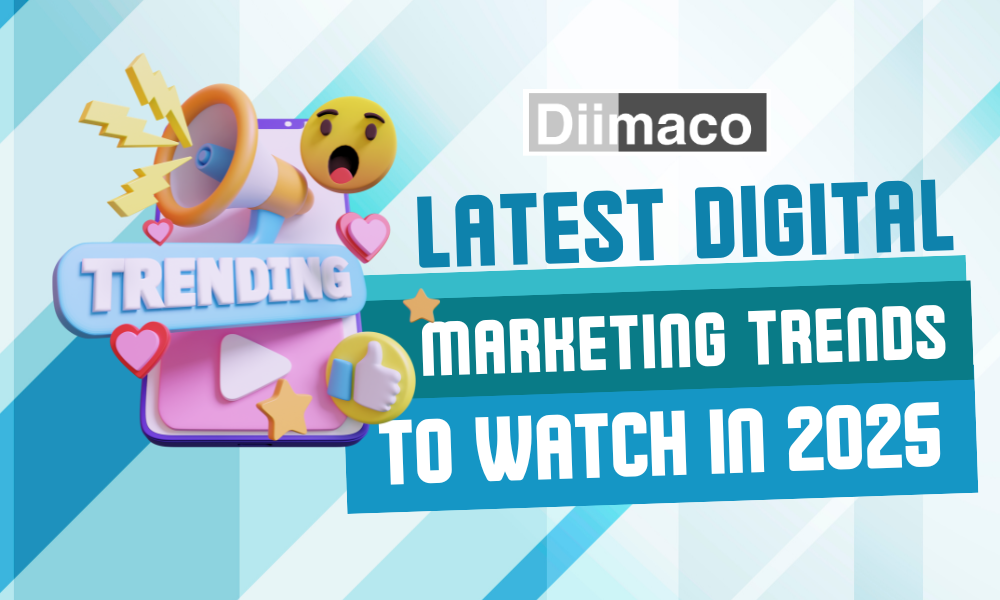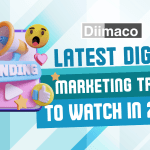Latest Digital Marketing Trends to Watch in 2025

Latest Digital Marketing Trends to Watch in 2025
As we approach 2025, the digital marketing landscape continues to evolve at lightning speed, driven by technological advancements, shifting consumer preferences, and a world that increasingly operates online. For businesses to stay competitive, understanding and adopting the latest trends is no longer optional but essential. Here’s a look at the top digital marketing trends shaping 2025.
- Artificial Intelligence (AI) Takes Center Stage
AI has been influencing digital marketing for a few years, but in 2025, it is expected to dominate more aspects of the customer journey. From chatbots providing real-time support to advanced AI algorithms that predict consumer behavior, marketers are using AI to deliver personalized experiences at scale. AI-driven tools like predictive analytics and natural language processing are making it easier for marketers to understand consumer needs, segment audiences, and create highly targeted campaigns.
Key Examples:
– AI-Powered Ad Campaigns: AI is optimizing ad placement, ensuring businesses reach the right audiences at the right time.
– Enhanced Personalization: AI creates dynamic content tailored to each user, improving engagement and conversion rates
- Voice Search Optimization (VSO)
Voice search is rapidly growing due to the widespread use of smart speakers and mobile assistants like Alexa, Google Assistant, and Siri. By 2025, it’s estimated that voice searches will account for over 50% of all search queries. This shift is forcing marketers to rethink their SEO strategies and optimize content for conversational queries rather than just traditional keywords.
Key Strategies:
– Focus on long-tail keywords and natural language that matches how people speak.
– Ensure local SEO is up to date, as voice searches are often location-based.
– Create FAQ pages that align with common voice search queries.
- The Rise of the Metaverse
The metaverse is poised to revolutionize digital marketing by providing immersive and interactive environments where brands can engage with consumers. Virtual and augmented reality experiences will be a crucial part of marketing strategies in 2025, allowing brands to offer more engaging and memorable interactions.
What to Expect:
– Virtual stores: Brands can create virtual shopping experiences where users try on products or tour virtual spaces.
– AR advertising: Augmented reality ads will become more popular, allowing users to interact with products directly from their devices.
- Sustainability Marketing
Consumers in 2025 are more eco-conscious than ever before. They are looking for brands that align with their values, particularly in terms of sustainability. Brands that prioritize eco-friendly practices and communicate them transparently in their marketing will build stronger connections with customers.
How to Leverage Sustainability Marketing:
– Share your brand’s green initiatives through storytelling and campaigns that resonate with environmentally-conscious consumers.
– Highlight sustainable products or packaging in your marketing efforts.
– Invest in carbon-neutral ad campaigns and focus on reducing your digital carbon footprint.
- Social Commerce
Social media platforms are becoming more integrated with e-commerce features, transforming the way consumers discover and buy products. Social commerce, where users can complete purchases directly within social media apps, is expected to see exponential growth in 2025. Platforms like Instagram, TikTok, and Pinterest are enhancing their in-app shopping features, allowing businesses to create seamless shopping experiences for consumers.
Key Benefits:
– Shoppable Posts: Brands can tag products in their posts, making it easy for users to buy without leaving the platform.
– Livestream Shopping: Livestream events where influencers or brand representatives showcase products in real-time will become more prominent.
- Video Content Dominates
Video marketing has been a dominant force for years, and in 2025, its importance is only growing. Short-form video content, like TikToks and Instagram Reels, is particularly effective in capturing attention. Additionally, the rise of live streaming and interactive video content provides brands with new opportunities to engage audiences.
Tips for 2025:
– Invest in snackable content that is quick and easy for users to consume.
– Explore live video to interact directly with audiences in real-time.
– Utilize interactive videos that allow users to make choices or interact with the content.
- Zero-Party Data and Privacy-Centric Marketing
With increasing privacy concerns and the decline of third-party cookies, marketers in 2025 are focusing on zero-party data — information that customers voluntarily share with brands. This shift emphasizes the importance of building trust and offering value in exchange for customer data. Brands will need to create meaningful experiences that encourage users to willingly provide their information.
Best Practices:
– Transparency: Be upfront about how you collect and use customer data.
– Offer value-driven incentives such as personalized offers or exclusive content in exchange for data.
– Focus on email marketing and other first-party data strategies.
- Influencer Marketing 2.0
Influencer marketing will continue to evolve in 2025, becoming more authentic and niche-driven. Consumers are increasingly drawn to micro and nano-influencers, who often have smaller but more engaged audiences. These influencers can foster genuine connections with their followers, making them ideal partners for brands looking to create trust and loyalty.
What’s New:
– Long-term partnerships with influencers will replace one-off campaigns, ensuring ongoing brand alignment.
– Niche influencers will play a larger role as consumers seek out more specialized content and communities.
Conclusion: Embrace the Future of Digital Marketing
2025 will be a pivotal year for digital marketers, with emerging technologies and shifting consumer behaviors creating both challenges and opportunities. Staying ahead means embracing AI, optimizing for voice and the metaverse, and aligning with consumer values like sustainability and privacy. By leveraging these trends, businesses can craft compelling, future-forward marketing strategies that resonate with the next generation of digital consumers.

 Previous Post
Previous Post Next Post
Next Post